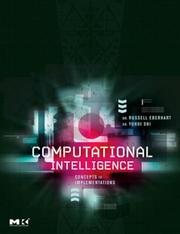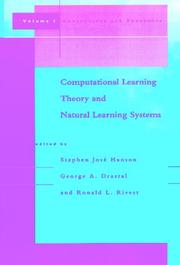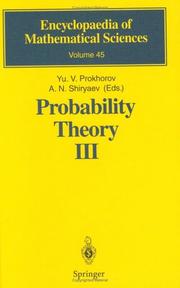| Listing 1 - 10 of 41 | << page >> |
Sort by
|
Periodical
ISSN: 2471285X
Abstract | Keywords | Export | Availability | Bookmark
 Loading...
Loading...Choose an application
- Reference Manager
- EndNote
- RefWorks (Direct export to RefWorks)
Multi
ISBN: 9783110671353 9783110668339 9783110655247 3110668335 3110671352 Year: 2020 Publisher: Berlin, Germany ; Boston, Massachusetts : Walter de Gruyter GmbH,
Abstract | Keywords | Export | Availability | Bookmark
 Loading...
Loading...Choose an application
- Reference Manager
- EndNote
- RefWorks (Direct export to RefWorks)
Computational intelligence (CI) lies at the interface between engineering and computer science; control engineering, where problems are solved using computer-assisted methods. Thus, it can be regarded as an indispensable basis for all artificial intelligence (AI) activities. This book collects surveys of most recent theoretical approaches focusing on fuzzy systems, neurocomputing, and nature inspired algorithms. It also presents surveys of up-to-date research and application with special focus on fuzzy systems as well as on applications in life sciences and neuronal computing.
Multi
ISBN: 9780128133279 0128133279 0128133147 9780128133149 Year: 2018 Publisher: London, United Kingdom : Academic Press, an imprint of Elsevier,
Abstract | Keywords | Export | Availability | Bookmark
 Loading...
Loading...Choose an application
- Reference Manager
- EndNote
- RefWorks (Direct export to RefWorks)
Computational Intelligence for Multimedia Big Data on the Cloud with Engineering Applications covers timely topics, including the neural network (NN), particle swarm optimization (PSO), evolutionary algorithm (GA), fuzzy sets (FS) and rough sets (RS), etc. Furthermore, the book highlights recent research on representative techniques to elaborate how a data-centric system formed a powerful platform for the processing of cloud hosted multimedia big data and how it could be analyzed, processed and characterized by CI. The book also provides a view on how techniques in CI can offer solutions in modeling, relationship pattern recognition, clustering and other problems in bioengineering. It is written for domain experts and developers who want to understand and explore the application of computational intelligence aspects (opportunities and challenges) for design and development of a data-centric system in the context of multimedia cloud, big data era and its related applications, such as smarter healthcare, homeland security, traffic control trading analysis and telecom, etc. Researchers and PhD students exploring the significance of data centric systems in the next paradigm of computing will find this book extremely useful.
Computational intelligence. --- Cloud computing. --- Big data.
Periodical
Abstract | Keywords | Export | Availability | Bookmark
 Loading...
Loading...Choose an application
- Reference Manager
- EndNote
- RefWorks (Direct export to RefWorks)
web intelligence --- system modelling --- data mining --- machine learning --- mathematical foundations of computational intelligence --- Computational intelligence --- Computational intelligence. --- Intelligence, Computational --- Artificial intelligence --- Soft computing --- Computer. Automation --- Computer Science

ISBN: 9781558607590 1558607595 9780080553832 0080553834 1281227706 9781281227706 9786611227708 6611227709 Year: 2007 Publisher: Amsterdam ; Boston : Elsevier/Morgan Kaufmann Publishers,
Abstract | Keywords | Export | Availability | Bookmark
 Loading...
Loading...Choose an application
- Reference Manager
- EndNote
- RefWorks (Direct export to RefWorks)
Russ Eberhart and Yuhui Shi have succeeded in integrating various natural and engineering disciplines to establish Computational Intelligence. This is the first comprehensive textbook, including lots of practical examples. -Shun-ichi Amari, RIKEN Brain Science Institute, JapanThis book is an excellent choice on its own, but, as in my case, will form the foundation for our advanced graduate courses in the CI disciplines. -James M. Keller, University of Missouri-ColumbiaThe excellent new book by Eberhart and Shi asserts that computational intelligence rests on a foundation of evo
Book
ISBN: 9781009258197 1009258192 Year: 2023 Publisher: Cambridge Cambridge University Press
Abstract | Keywords | Export | Availability | Bookmark
 Loading...
Loading...Choose an application
- Reference Manager
- EndNote
- RefWorks (Direct export to RefWorks)
"Fully revised and updated, this comprehensive new edition covers modern AI and machine learning for undergraduate and graduate students. Includes new chapters on deep learning including generative AI, causality and social impact, new social impact sections, major revisions to knowledge graphs, reasoning and decision-making, and more AIPython code"--
Periodical
ISSN: 1556603X Publisher: New York (N.Y.) : IEEE press,
Abstract | Keywords | Export | Availability | Bookmark
 Loading...
Loading...Choose an application
- Reference Manager
- EndNote
- RefWorks (Direct export to RefWorks)
Artificial intelligence. Robotics. Simulation. Graphics --- KI (kunstmatige intelligentie) --- Electrical engineering --- #TS:WBIB --- Periodicals --- Computational intelligence --- Intelligence informatique --- Computational intelligence. --- Intelligence informatique. --- Information Technology --- Artificial Intelligence --- Elektrotechniek --- Artificiële intelligentie. Robotica. Simulatie. Graphics --- AI (artificiële intelligentie)
Multi
ISBN: 9789811940590 9789811940583 9789811940606 9789811940613 Year: 2022 Publisher: Singapore Springer Nature Singapore :Imprint: Springer
Abstract | Keywords | Export | Availability | Bookmark
 Loading...
Loading...Choose an application
- Reference Manager
- EndNote
- RefWorks (Direct export to RefWorks)
This book presents thoughts and pathways to build revolutionary machine learning models with the new paradigm of machine learning to adapt behaviorism. It focuses on two aspects – one focuses on architecting a choice process to lead users on the certain choice path while the second focuses on developing machine learning models based on choice paradigm. This book is divided in three parts where part one deals with human choice and choice architecting models with stories of choice architects. Second part closely studies human choosing models and deliberates on developing machine learning models based on the human choice paradigm. Third part takes you further to look at machine learning based choice architecture. The proposed pioneering choice-based paradigm for machine learning presented in the book will help readers to develop products – help readers to solve problems in a more humanish way and to negotiate with uncertainty in a more graceful but in an objective way. It will help to create unprecedented value for business and society. Further, it will unveil a new paradigm for modern intelligent businesses to embark on the new journey; the journey of transition from shackled feature rich and choice poor systems to feature flexible and choice rich natural behaviors.
Computer science --- Programming --- Artificial intelligence. Robotics. Simulation. Graphics --- Computer. Automation --- neuronale netwerken --- fuzzy logic --- cybernetica --- informatica --- programmeren (informatica) --- wiskunde --- KI (kunstmatige intelligentie) --- Computational intelligence. --- Machine learning. --- Computational Intelligence. --- Machine Learning. --- Mathematics of Computing. --- Mathematics. --- Consumer behavior --- AI (artificiële intelligentie)

ISBN: 0262581264 0262581337 0262660962 026228684X 0585368929 0262315831 9780262291132 9780262571180 0262291134 0262571188 9780262581332 9780262286848 9780262315838 9780262581264 9780262660969 0585024464 Year: 1994 Publisher: Cambridge, Mass. MIT
Abstract | Keywords | Export | Availability | Bookmark
 Loading...
Loading...Choose an application
- Reference Manager
- EndNote
- RefWorks (Direct export to RefWorks)
Artificial intelligence. Robotics. Simulation. Graphics --- Computational learning theory --- Théorie de l'apprentissage informatique --- Congresses. --- Congrès --- Computational intelligence. --- Machine learning --- Intelligence, Computational --- Artificial intelligence --- Soft computing

ISBN: 3540546871 3642081223 3662036401 Year: 1998 Volume: 45 Publisher: Berlin Springer
Abstract | Keywords | Export | Availability | Bookmark
 Loading...
Loading...Choose an application
- Reference Manager
- EndNote
- RefWorks (Direct export to RefWorks)
Preface In the axioms of probability theory proposed by Kolmogorov the basic "probabilistic" object is the concept of a probability model or probability space. This is a triple (n, F, P), where n is the space of elementary events or outcomes, F is a a-algebra of subsets of n announced by the events and P is a probability measure or a probability on the measure space (n, F). This generally accepted system of axioms of probability theory proved to be so successful that, apart from its simplicity, it enabled one to embrace the classical branches of probability theory and, at the same time, it paved the way for the development of new chapters in it, in particular, the theory of random (or stochastic) processes. In the theory of random processes, various classes of processes have been studied in depth. Theories of processes with independent increments, Markov processes, stationary processes, among others, have been constructed. In the formation and development of the theory of random processes, a significant event was the realization that the construction of a "general theory of ran dom processes" requires the introduction of a flow of a-algebras (a filtration) F = (Ftk::o supplementing the triple (n, F, P), where F is interpreted as t the collection of events from F observable up to time t.
Stochastic processes --- Processus stochastiques --- Stochastic processes. --- Probabilities. --- Statistics . --- Computational intelligence. --- Finance. --- Probability Theory and Stochastic Processes. --- Statistics, general. --- Computational Intelligence. --- Finance, general. --- Funding --- Funds --- Economics --- Currency question --- Intelligence, Computational --- Artificial intelligence --- Soft computing --- Statistical analysis --- Statistical data --- Statistical methods --- Statistical science --- Mathematics --- Econometrics --- Probability --- Statistical inference --- Combinations --- Chance --- Least squares --- Mathematical statistics --- Risk
| Listing 1 - 10 of 41 | << page >> |
Sort by
|

 Search
Search Feedback
Feedback About UniCat
About UniCat  Help
Help News
News